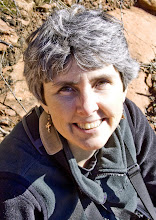At your suggestion, I entered this photo into The National Photography Competition and it is one of 50 finalists to be included in an exhibition at the von Liebig Art Center in Naples, Florida that will run from May through August. Stay tuned to see how I fare in the final round. Sadly, I won't be able to attend the opening reception in May to hear the announcement of the grand prize winner and a lecture by the judge, Harry Benson. I admire his photography.
This photo is one that I took on one of my recent trips to DC. It is of the a reflection of a path towards the Washington Monument, reflected in the wall of the Vietnam Veteran's Memorial. The wall is made from gabbro, a mineral chosen from its highly reflective quality. Enscribed on the wall are the 58,175 names of US forces killed or missing in action from the war.
I took the photo with my Nikon D300 (handheld because the park police frown on tripods on the mall) with a small aperture (f 16) to have a long depth of field to get as many names in focus as possible and a shutter speed of 1/125 (ISO 200). I got lucky with this shot and had to do very little processing in Photoshop.
Tuesday, April 5, 2011
Thank you Nilda and Carrie...
Sunday, April 3, 2011
Getting the Most from Your iPhone (Part 4) - Turning Bad Light Into Interesting Light
At the most basic level, photography is about capturing light. Imagine that light is being painted onto objects and that you are capturing a moment in time-- the first light of sunrise onto the side of a building, light streaming through a window onto a floor, or a scene fully illuminated by the midday sun. Sometimes, it seems that the light is "bad", on a day where it's cloudy, rainy, etc. In this photo that I took when traveling to DC to photograph cherry blossoms in what I hoped to be scintillating spring sunshine, I instead found myself dodging raindrops and making the most of it with occasional sunbreaks. This photo, Interesting Light, of the Thomas Jefferson Memorial, shows how to maximize less than ideal light for interesting effects.
First: I used the ProHDR app (described in a previous posting) to make the most of the available light and even out the bright areas and the shadows.
Second: I maximized the use of reflection. By including the reflection in the Tidal Basin to essentially "double" the light. By having the bright patches of sky appear twice, it lightens the photo. Reflections in general add interest to photos.
Third: Include elements with high contrast, especially white objects, e.g. in this the dome of the monument and the cherry blossoms on the trees. These also serve to multiply light by having additional elements reflect light back to your eye.
